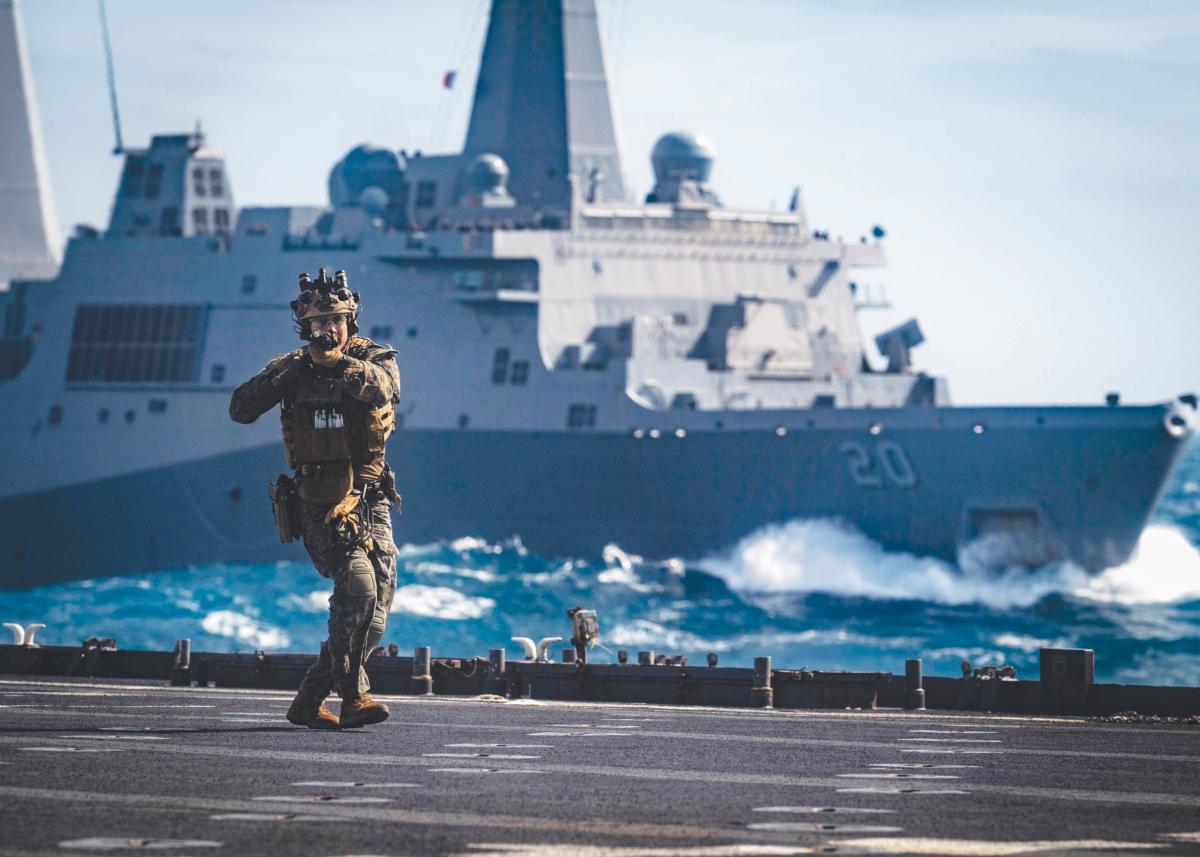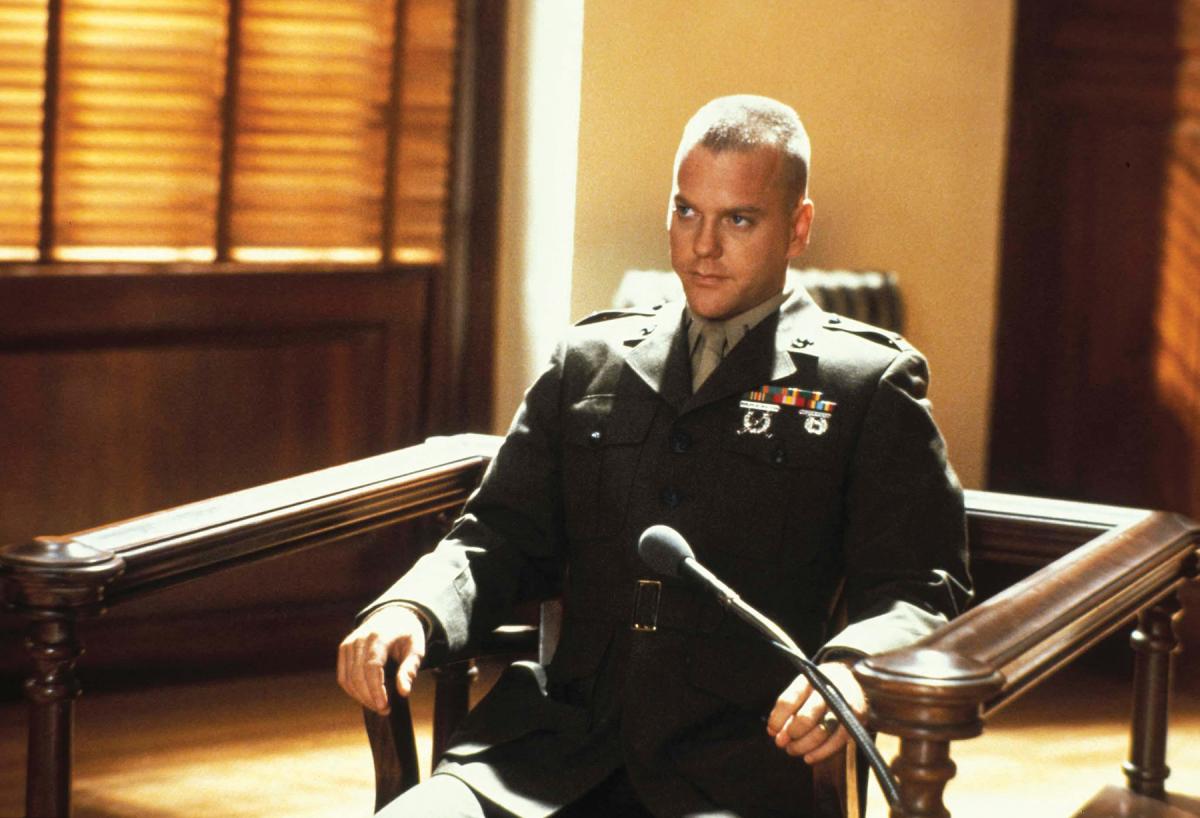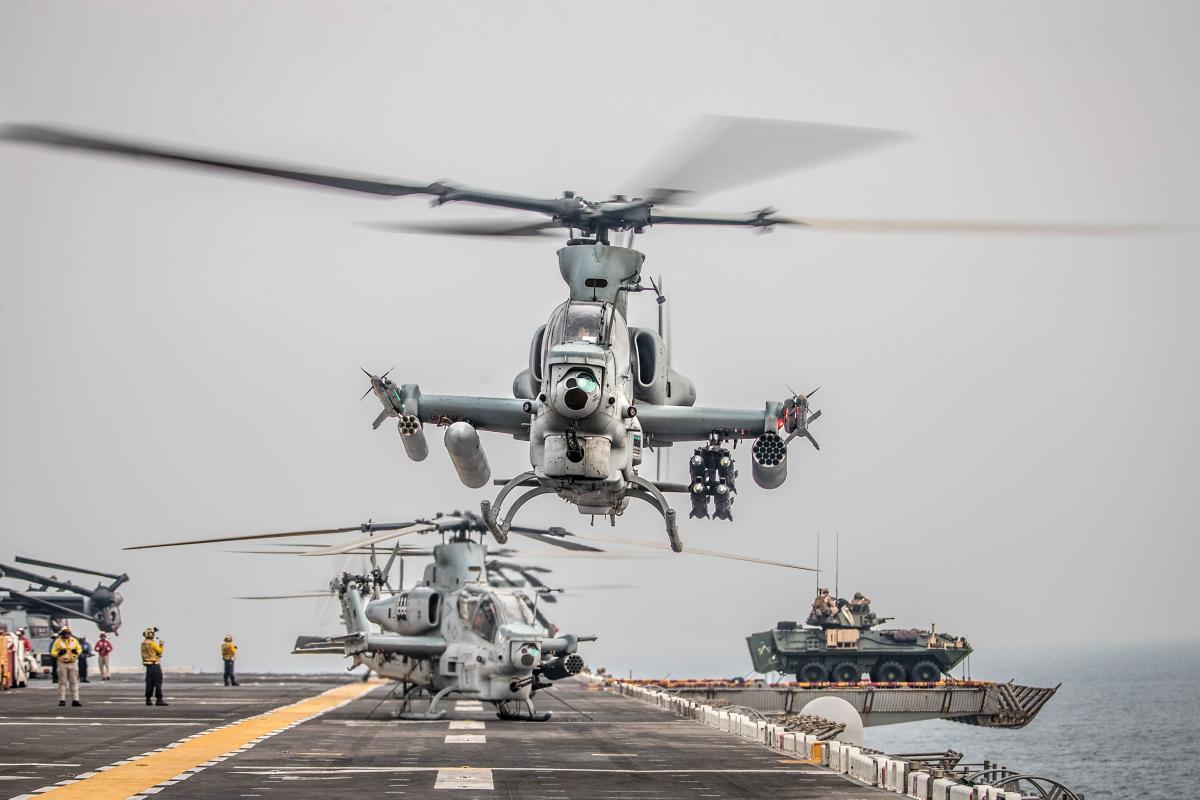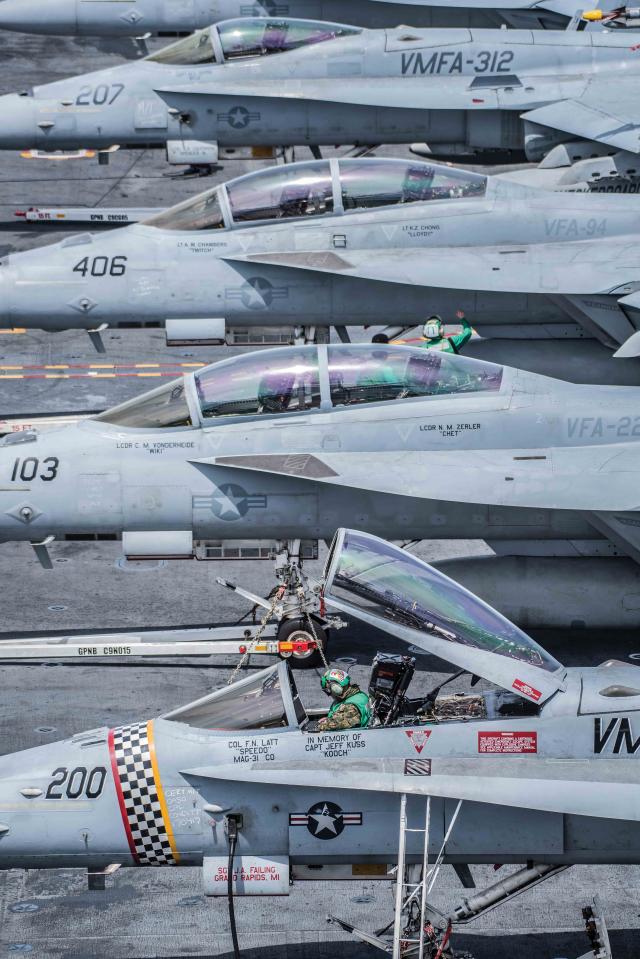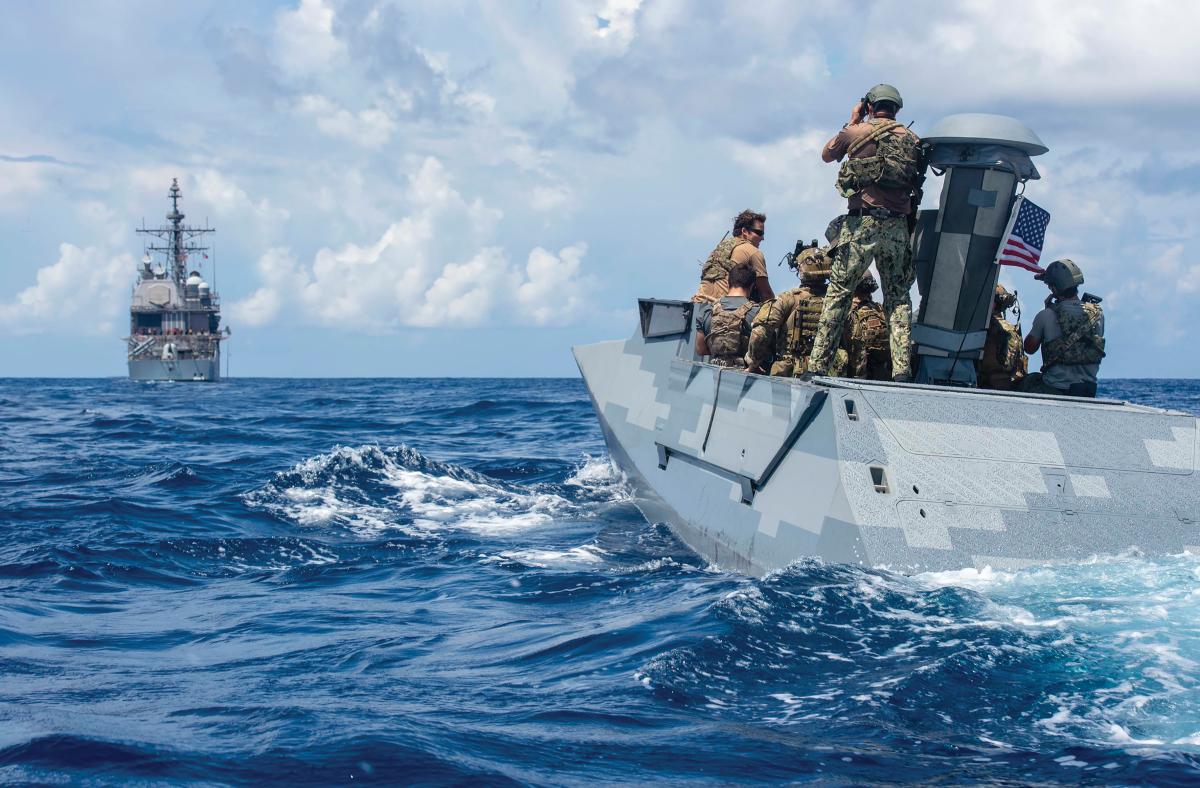On the eve of the First World War, the Marine Corps grappled with its identity, seeking to articulate a mission and a doctrine.1 Despite famous victories in that war, the Corps’ existential conflict was not resolved until 1933, when the service transformed itself into the “Fleet Marine Force” (FMF).2 Marine Corps forces were subordinated to the immediate needs of the Navy, placed under operational control of fleet commanders, and employed as an extension of the fleet. This force design was critical to the success of the island-hopping campaign in the Pacific during the Second World War and facilitated naval superiority in the global maritime commons through most of the remaining century.3
But as the 20th century came to an end, the Corps drifted from its focus on naval integration. While the 1986 Goldwater-Nichols Act put a premium on jointness, it paradoxically strengthened the independent componency of the Marine Corps at the expense of interdependence with the Navy. The Marine Corps reorganized itself to stand on its own and marketed itself to combatant commanders on the efficacy of the Marine air-ground task force (MAGTF). If the Navy could get the Corps to the fight, Marines would take matters from there. As the Corps’ unrivaled performance in operations Desert Storm and Iraqi Freedom demonstrated, this model was effective, despite a cost to the service’s ability to support naval operations.
After two decades of Marine Corps employment as a second land army in the Middle East and Southwest Asia, outside observers would have difficulty asserting that the Marine Corps is a naval force by any means. The Corps is adrift. From 1986 to today, the primary question asked of the Navy by Marine Corps planners has been, “What can the Navy do for the Marine Corps?”
The Commandant’s Planning Guidance
This is changing fast.
In the opening days of his tenure as 38th Commandant of the Marine Corps (CMC), General David Berger issued comprehensive guidance directing the Corps to immediately reorganize itself as a naval expeditionary force, in the manner of the FMF, to operate as an extension of the fleet.4 The Commandant’s Planning Guidance (CPG) demands that Marine Corps planners now ask, “What can the Marine Corps do for the Navy?” Force design is the first priority, and the Commandant is willing to divest the service of whatever is necessary to radically transform the inventory of the force to ensure his vision will be realized.5
The guidance tips over sacred cows such as the traditional employment of the MAGTF, the role of the Marine Expeditionary Forces (MEF), and the utility of the Maritime Prepositioning Force (MPF). Navy leaders may see an abundance of risk in this, but the CPG thoughtfully addresses the challenges this vision will bring. The 23-page document discusses risk 26 times, articulating the value to be gained from the trade-offs.6 But the document does not address perhaps the most essential danger to this vision: Is the Marine Corps building something the Navy wants?
Wag the Dog?
In four years, the Marine Corps’ manning, organization, and training will be radically transformed. But though the Commandant seeks to better nest the Corps within the Navy, it is unclear if the CPG nests within the Navy’s vision of its future. There is no reference to the efforts of the Commandant’s guidance or a vision on future Marine Corps employment in any unclassified Navy strategic guidance. The only document that even comes close is A Design for Maintaining Maritime Superiority Version 2.0 (Design 2.0), which vaguely references deepening naval integration with other services and prioritizes integration with the Marine Corps. A careful reading of Design 2.0 shows no alignment with the CPG, and in any case, it provides nothing with enough granularity for action by Navy planners.7
The Corps is “leading up” and leading fast in its effort to build a force that will better support Navy efforts to succeed in an increasingly complex and contested maritime domain, characterized by growing antiaccess/area denial (A2AD) threats. The Corps’ rapid pace offers benefits—it cuts through bureaucratic inertia that typically would stifle such (refreshingly) radical change. And it reduces the likelihood that institutional inertia will cause this vision to wither on the vine. But there is great danger in letting the Marine tail wag the naval dog. In four years, the Corps will have radically transformed itself and made changes that will have decades-long impacts, and it will exist in a form that the Marine Corps believes the Navy needs. But will this be what the Navy believes it needs? The Marine Corps wants a transformation to happen, but will the Navy employ the transformed service?
The CPG is aware of this. It notes, “We should ask ourselves—what do the Fleet Commanders want from the Marine Corps, and what does the Navy need from the Marine Corps?” But it is incumbent on the Navy to answer these questions! The Navy cannot leave the Marine Corps to wrestle with these issues alone. If the Navy does not engage now, it will fail to capitalize on the opportunity this moment provides. If the Navy wants to ensure the Corps will be its naval expeditionary force, employable as an FMF in support of fleet operations as a true extension of the fleet, it must ensure that Marine Corps transformation aligns with the Navy’s strategic vision. The Navy must harness the CPG to best employ the Marine Corps.
Integrate and Execute—Faster
Navy force designers must move faster. It is natural that planners move at a measured pace in a service where planning, constructing, and maintaining ships are tasks measured in years. But this approach bleeds easily into functional areas that could be quicker and more nimble. Design 2.0 directs the Navy to become more agile in conceptual, geographic, and technological spaces, but this will be impossible without also increasing agility in process spaces.8
Force design planning in the Marine Corps is going at a dead sprint. The Navy could respond by telling the Corps to slow down, but this would be a poor decision. The CPG demands transformation to provide the Navy and the nation with a force that can stay ahead of adversary capabilities. It seeks success primarily through deterrence—providing a force that will prevent conflict, rather than winning costly, unavoidable fights.9 To tell the Corps to slow down would cede the initiative to adversaries, dooming landing forces to pay a grisly butcher’s bill that could otherwise have been sidestepped. Instead, the Deputy Chief of Naval Operations (CNO) for Plans and Strategy and other appropriate offices should rapidly develop a vision for employing the Marine Corps that harnesses the initiative and creativity of the CPG and integrates with Marine Corps planners to ensure Marine Corps force design aligns with the intent of Design 2.0 (or whatever guidance from the new CNO replaces it). This must be completed in months not years, or the potential value of the CPG may be lost to the Navy.
Inform Amphibious Capability
The CPG discusses seeking amphibious deployment by means other than the amphibious assault “L-ships,” with an emphasis on “the affordable and plentiful at the expense of the exquisite and few.”10 It seeks to avoid presenting the adversary with a lucrative target of concentrated forces on board a few ships by creating “a new fleet design of smaller, more lethal, and more risk-worthy platforms.”11 Surprisingly, Design 2.0 does not address amphibious capabilities at all and vaguely refers to Marine Corps integration only a single time.
The call to mature the distributed maritime operations (DMO) concept suggests a mechanism to align Navy and Marine Corps planning for future amphibious capability. But the Navy must articulate how amphibious forces should support fleet operations, lest the Marine Corps develop incompatible concepts absent such guidance. The Navy also must determine how Marine forces can be an extension of the fleet, as this will necessarily inform the development and selection of amphibious platforms and connectors. Otherwise, the Marine Corps’ solutions could wind up supporting the CPG’s vision for amphibious capability but fail to support the Navy’s vision for DMO.
Inform Sea-Denial/Sea-Control Concepts
Remarkably, Design 2.0 fails to discuss sea control in any detail, and mentions sea denial not at all. Sea control only comes up as a preamble: “It has been decades since we last competed for sea control,” but no discussion on how to compete for sea control today follows.12 By contrast, the CPG mentions sea control eight times, sea denial four times, and explicitly dictates that the transformed Corps will be “purpose-built to facilitate sea denial and assured access in support of the fleets.”13 This will be accomplished by placing ground-based, long-range precision fires ashore inside the adversary’s weapons engagement zone (WEZ), putting the enemy’s sea lines of communication in check, and providing fleet commanders with assured access.14 If the Navy concurs with this vision, it must take all necessary steps to enable this concept of employment.
The Navy will need new doctrine to guide operations to place forces ashore inside the WEZ and to employ them to have the best effect on an adversary’s decision-making calculus. Once developed, this doctrine must be practiced with regularity, until Marine companies are capable of inserting, deploying fires, and inflicting sea control inside the enemy’s A2AD arc. The Navy must deploy Marines on board its non-amphibious ships, so Navy and Marine leaders at every rank can rehearse until they become intimately familiar with these critical and difficult skills.
The force design question could lead the Corps to divest itself of some infantry and armor, because the sea-control vision aligns more closely with the mission of artillery than of those two branches. And artillery could redesign and invest in capabilities tailored for sea control and sea denial. Alternatively, infantry units may train less for traditional infantry mission-essential tasks (METs) and become more capable in artillery METs. This is not without precedent—as operations Iraqi Freedom and Enduring Freedom wore on, many artillery units, no longer required to perform their core mission, were repurposed as provisional infantry. The application of the CPG may result in something similar, this time repurposing infantry as provisional artillery. However the CPG is executed, it is essential the Navy participate in the process that will decisively shape the Corps the Navy will employ.
Align Security Cooperation and Sea Control
In the future fight, the Navy and Marine Corps likely will not fight alone but as part of a coalition of allies and partners. The Marine Corps has a tradition of security cooperation (SC) expertise going back to the days of the Banana Wars, recently refined by nearly two decades of SC experience in support of counterinsurgency operations. This experience is critical enough that the Marine Corps now awards a foreign security forces military occupational specialty (MOS) to better track the inventory of SC-qualified Marines. The expeditionary advanced base operations (EABO) concept—around which the CPG’s sea-denial and sea-control vision is built—takes place inside the WEZ, where many U.S. allies and partners live every day.
While Marines will continue to participate in security cooperation missions independent of sea control, there exists an opportunity to align this task to better support the fleet. SC teams can train partners and allies to employ platforms that provide sea control and denial. With proper planning, SC missions can support anticipated fleet operations. In this manner, the Marine Corps’ legacy of fighting small wars can be uniquely leveraged in support of fleet commanders.
The Corps on Target
The Commandant’s Planning Guidance attempts to answer the question, “What can the Marine Corps do for the Navy?” But absent clear strategic guidance from the Navy, the Corps may be imagining itself into a force the Navy could be ill-prepared to employ. The Corps is moving in the right direction, but the Navy’s vision for DMO needs to take better account of the Marine Corps’ vision. Only when the two services have aligned their thinking will the Navy ensure the Corps is on target and appropriately nested to maximize its ability to support the Navy in deterring aggression and settling conflict on the United States’ terms.
1. MAJ John H. Russell, USMC, “A Plea for a Mission and Doctrine,” The Marine Corps Gazette 1, no. 2, (Spring 1916): 109.
2. MGEN John H. Russell, USMC, “The Fleet Marine Force,” U.S. Naval Institute Proceedings 62, no. 10 (October 1936).
3. Merrill L. Bartlett, “Ben Hebard Fuller and the Genesis of a Modern United States Marine Corps, 1891–1934,” The Journal of Military History 60, no. 1 (Lexington, VA: Society for Military History, 2005): 85-90
4. GEN David Berger, USMC, 38th Commandant’s Planning Guidance (Washington, D.C.: Headquarters Marine Corps, 2019), 1.
5. Berger, Commandant’s Planning Guidance, 2.
6. Berger, 1–23.
7. ADM John Richardson, USN, A Design for Maintaining Maritime Superiority Version 2.0 (Washington, D.C.: Office of the Chief of Naval Operations, 2018), 14.
8. Richardson, Design 2.0, 5.
9. Scott Cuomo, Olivia Garard, Noah Spataro, Jeff Cummings, “Not Yet Openly at War, But Still Mostly at Peace: The Marine Corps’ Roles and Missions in and around Key Maritime Terrain,” War on the Rocks.
10. Berger, Commandant’s Planning Guidance, 4.
11. Berger, 4.
12. Richardson, Design 2.0, 3.
13. Richardson, 5.
14. Berger, Commandant’s Planning Guidance, 13.



